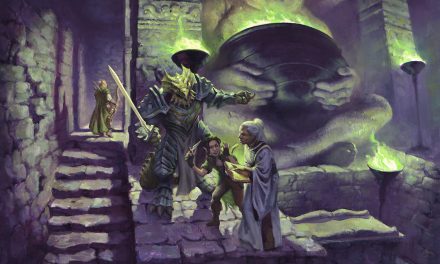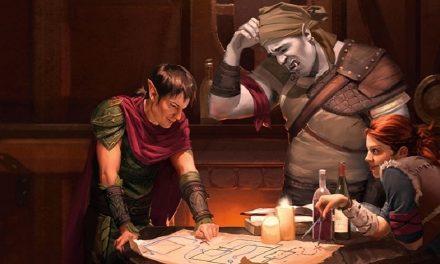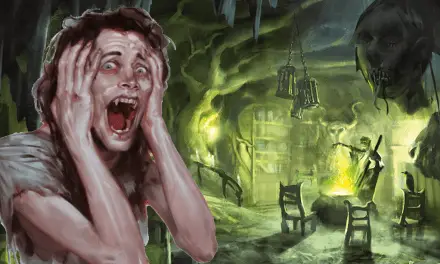For any Dungeon Master, there are several tools that you will need to run your games smoothly.
Some of these are mandatory must-haves and others are just incredibly nice to have handy.
You won’t want to sit in the DM seat without this collection of the best physical tools for Dungeon Masters!
Dice
It almost goes without saying, but dice are the single most important physical tool that DM needs.
When you’re running the game, you’re going to be doing a ton of rolling. Whether it’s attacks and saves in combat, determining encounters or loot on random tables, or just to keep your players on their toes, you’ll need plenty of dice.
For the money, I absolutely swear by the Wiz Dice bags of dice.
Because each bag has 20 complete sets of dice, you’ll never find yourself fumbling around for that elusive d8 when trying to make a roll. (Why is it always the d8?!)
These dice are a very good quality as well. Most of my dice are from these bags and they are always shaped evenly to prevent cocked rolls. Plus, the bags themselves are sturdy and have really cool designs. (Personally, I’m fond of the Bag of Devouring since I especially love running horror games.)
Books
At the minimum, a Dungeon Master must have the Player’s Handbook and Monster Manual.
Assuming that you have those, my next biggest picks for Dungeon Masters are Volo’s Guide to Monsters and Mordenkainen’s Tome of Foes.
Both of these books do a wonderful job at providing a huge assortment of new monsters and wonderfully juicy lore for DMs.
Because both of these books have such a trove of options and lore, I find it impossible to choose between them. Whether you’re looking to learn more about the Forgotten Realms or are just looking for new enemies to really shake up your encounters, these should be on every DM’s bookshelf.
Stationary
Pens, paper, notebooks, dividers…
The trick to running a flawless D&D adventure lies in the preparation and organization.
Making notes of important events and characters will help you when making callbacks. Similarly, it’s wise to have some general notes for the game that you have planned when you sit down at the table.
I like to also keep notes on my players and their characters. What are their goals? What types of situations does the player seem to be enjoying the most? These are incredibly useful when I’m planning sessions so that I can make sure that there’s something for everybody!
You can go as crazy with stationary as you want or need for keeping track of your game. The vast majority of dollar stores usually have a ton of notebooks, pens, and what not for very cheap prices. Considering how much you’re likely to use, it’s worth buying them as cheap as possible!
Dungeon Master Screen
The famous DM screen isn’t just for concealing your rolls and evil plans!
Most importantly, the DM screen functions as extra space for you to keep important notes.
A couple of years ago, I impulsively bought this screen from Stratagem and have never regretted it.
The official DM screens from Wizards of the Coast are always pretty, but I like to have something that I can adapt and get tons of use out of. The ability to create my own inserts and keep them safely tucked away in the screen is one of my favorite things about this DM screen.
It does come with inserts that are certain to be very useful when you’re trying to run the game. With inserts detailing combat, conditions, space for tracking the characters’ stats, and other incredibly useful information, you won’t get caught stumbling on any game mechanics.
The sheer value of having a DM screen that is well laid-out is impossible to understate. Few things are more awkward than having to pause the game to thumb through a book to look up a rule in the middle of combat.
“Let me just look it up in the PHB… oh wait… maybe it was the Dungeon Master’s Guide… wait… no it’s not here… was it in the PHB?”
Miniatures
Theatre of the mind is a great thing, but using miniatures is where your game will come alive.
We’ll get into the world of miniature painting later, but for those who want miniatures that are already painted, WizKids release pre-painted miniatures for every book that comes out.
I particularly like the ones released with Mythic Odysseys of Theros.
If you’re looking to use miniatures in your game (and trust me, they help SO MUCH), you’ll also want to invest in something to use those miniatures on.
I’m a huge fan of the D&D Dungeon Tiles as a quick tool for building terrain and dungeons. Having the environment right there in front of you is important when it comes to combat tactics and decisions. When my group made the switch from “theatre of the mind” to using these, it was a night and day switch!
Before I got the Dungeon Tiles, we were using a Chessex Battlemat and drawing the dungeons on it with dry-erase markers. It’s not as “fancy” as using the Dungeon Tiles, but it still works wonderfully for adding that extra level of tactics to your game’s combat.
Initiative Tracker
For years, my groups just kept track of initiative on paper or on an Excel sheet.
But the Pathfinder Combat Pad is genius for tracking initiative and has really added to our games. Particularly in those big combats, this little gem has kept our games moving in an orderly manner.
Seriously… Nothing breaks the immersion of those white-knuckle combats against the boss and their legion of minions like going “uhh… who’s turn is it again?”
Plus, everyone at the table can plainly see where they are in combat. For spellcasters, in particular, this lets them know how much time they have to plan their next spell and look up the effects.
Because it’s a dry-erase board, it’s very easy to clean. Additionally, there’s plenty of space for adding important notes and you can get a ton of use out of this.
With 13 magnets for players, 13 for enemies, and 9 for NPCs who have found themselves in the scuffle, nobody will get forgotten!
Your combats will thank you!









